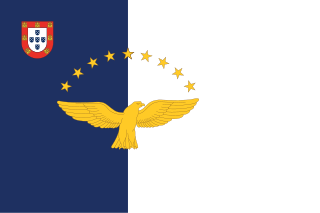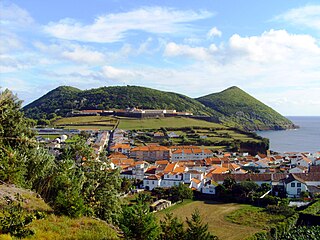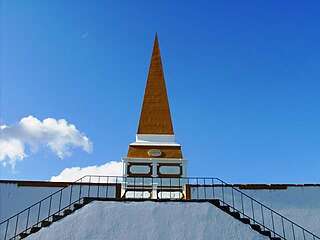Postage stamps and postal history of the Azores surveys the postal history of the Portuguese archipelago, situated in the north Atlantic.
Contents

Postage stamps and postal history of the Azores surveys the postal history of the Portuguese archipelago, situated in the north Atlantic.

The first stamps used in the Azores were Portuguese stamps issued in 1853 depicting the effigy of Queen D. Maria II, which were designed by Francisco de Borja Freire and printed by the Casa da Moeda. [1] The stamps were inspired by English stamps issued between 1847 and 1848, presenting a bust of the Queen (similar to coin minted in the period) and printed one-by-one in sheets of 24 examples, without perforations and arranged irregularly. [1] The first two stamps (that began circulating on 1 July 1853) had a facial cost of 5 and 25 réis. [1] The following day, issues of 100 réis, and on 22 July 1853, 50 réis were available. Portugal was the 45th nation to adopt the use of postage stamp. [1]
In the Azores, then known as the Ilhas Adjacentes (Adjacent Islands), stamps were cancelled with circular postmark between 1853 and 1869 (referred to as the First Reform) that included numerals corresponding to the localities: [1]
Between 1869 and 1878 oval postmarks began to be used (the Second Postal Reform), with new postal designations: [1]


The first stamps for the Azores appeared in 1868, and continued until 1930. Nearly all of the stamps issued in the Azores were Portuguese stamps overprinted with "AÇORES". The exceptions were the 1898 Vasco da Gama commemorative issue, the 1906 King Carlos issue, and the 1910 King Manuel issue (including revolutionary overprints on the Manuel issue). After 1930, Portuguese stamps were used in the Azores.


Between 1892 and 1906, the three administrative districts of the Azores had stamps issued inscribed with their names: Angra, Horta and Ponta Delgada. The designs were identical to those of the regular Portuguese stamps (which were inscribed "CONTINENTE"), with the colors generally the same, although some were lighter or darker.
On 2 January 1980, the use of separate stamps for the Azores (and Madeira) were revived. The modern stamps are inscribed both "PORTUGAL" and "AÇORES".
Personalized and regional stamps began to be issued from 2008 by the Portuguese postal service. [1] These stamps have no special purpose beyond the expression of local pride; all are sold and valid in Portugal. About 5-10 are issued each year, generally with themes relating to the Azores.

The Azores, officially the Autonomous Region of the Azores, is one of the two autonomous regions of Portugal. It is an archipelago composed of nine volcanic islands in the Macaronesia region of the North Atlantic Ocean, about 1,400 km (870 mi) west of Lisbon, about 1,500 km (930 mi) northwest of Morocco, and about 1,930 km (1,200 mi) southeast of Newfoundland, Canada.

Angra do Heroísmo, or simply Angra, is a city and municipality on Terceira Island, Portugal, and one of the three capital cities of the Azores. Founded in 1478, Angra was historically the most important city in the Azores, as seat of the Bishop of the Azores, government entities, and having previously served as the capital city of Portugal during the Liberal Wars. The population in 2011 was 35,402, in an area of 239.00 km2. It was classified as a World Heritage site by UNESCO in 1983.

The University of the Azores, or commonly abbreviated as UAc, is the only public university in the Autonomous Region of the Azores. It was founded on January 9, 1976, two years after the Carnation Revolution that ended several decades of dictatorship in Portugal, but before the Portuguese Third Republic was institutionalized, along with the region's autonomy. The university is a public institution dependent on the Ministry of Science, Technology and Higher Education and was established in order to advance sustainable development and higher education in the Azores.

The District of Ponta Delgada was a district of the Ilhas Adjacentes, consisting of the dependent eastern islands of the Azores, located in the Atlantic Ocean. The district of Ponta Delgada, not to be confused with the modern municipality of Ponta Delgada, existed from 1835 until 1976 when it was abolished in the favour of the autonomy charter of the 1975 Portuguese Constitution.
The Historical Institute of Terceira, or literally the Historical Institute of the Island of Terceira, or IHIT, is a private association and cultural institute and museum, dedicated to the investigation and studying of the islands of the Azores. The institute is headquartered in the classical Convent of São Francisco in Angra do Heroísmo.

The Fortress of São João Baptista, also known as the Fort of São Filipe or Fort of Monte Brasil is a historic fortress and defensive emplacement, located in the civil parish of Sé, municipality of Angra do Heroísmo in the Portuguese island of Terceira, archipelago of the Azores.

The Castle of Moinhos, officially known as the Castle of São Cristóvão, or Castle/Fort of São Luís is the name of the ruins of 16th-century fortification in city of Angra, on the Portuguese island of Terceira in the archipelago of the Azores. It is primarily known as the Castle of Moinhos, owing to the popular name given to the site for the number of mills that dotted the hilltop, on which the castle was erected.
The Fort of Má Ferramenta, near the port of the civil parish of São Mateus da Calheta, municipality of Angra do Heroísmo, along the southern coast of the Portuguese island of Terceira, in the archipelago of the Azores. Located in a dominant position over this coastal stretch of coast that sheltered anchored ships, it was a fortification used as a defence against attacks from pirates and corsairs, that frequented the waters of the mid-Atlantic.

Fort of São João, also known as Fort of Biscoitinho, is a medieval fort, in the civil parish of São Mateus da Calheta, in the municipality of Angra do Heroísmo, on the Portuguese archipelago of the Azores.

The Fort of Cinco Ribeiras, also known as the Fort of Nossa Senhora do Pilar or Fort of São Bartolomeu, ruins of a 16th-century fortification located in the municipality of Angra do Heroísmo, along the southeast coast of Terceira, Portuguese archipelago of the Azores.
Fort of the Cavalas is a fort situated in the civil parish of São Sebastião in the municipality of Angra do Heroísmo, in the Portuguese archipelago of the Azores.
Aviation in the Azores is part of the greater history of aviation in Portugal, and involves the historical use of the archipelago of the Azores by North American, South American and European pioneers of aviation. The Azores is strategically located in the centre of the North Atlantic Ocean between the continents of North America and Europe, and has played a historical role in trans-Atlantic navigation. The three primary airfields of the Azores are:
José Guilherme Reis LeiteGC IH, is a professor, historian and Azorean politician, whose functions included his role as Regional Secretary for Education and Culture, deputy and President of the Legislative Assembly of the Azores, in addition to representative for the Azores in the Portuguese National Assembly.

Gaspar de Faria, was the 6th Bishop of Angra, governing the Diocese between 1571 and 1576.
The Fort of the Church São Mateus da Calheta, also referred to as the Forte da Igreja, are the coastal ruins of a 16th-century fort situated in the civil parish of São Mateus da Calheta, municipality of Angra do Heroísmo, on the Portuguese island of Terceira, in the archipelago of the Azores. It was destroyed, along with the church, in 1893 during a cyclone; while the church was eventually reconstructed some years later, the fort was abandoned and left to ruin.
The Fort of the Espírito Santo is the remains of a 16th-century fortification located on the extreme northern edge of the Bay of Praia da Vitória, in the Portuguese civil parish of Santa Cruz, municipality of Praia da Vitória, on the island of Terceira, in the Azores.
The Captaincy General of the Azores was a politico-administrative structure of governance imposed in the Azores on 2 August 1766, with its seat in Angra. It remained the de facto system of governance for 65 years, until it was abolished on 4 June 1832 by D. Peter IV, but by 1828 its de jure status had made it nonoperational, owing to the revolutionary movements that lead to the Liberal Wars. The creation of the Captaincy-General was part of the Pombaline reforms to the Portuguese administration, during the reign of Joseph I, under the initiatives of Sebastião José de Carvalho e Melo, 1st Marquis of Pombal, then prime minister. A Captaincy-General operated from the Palace of the Captains-General, under the direction of the titular Captain-General, who operated as the Governor of the Azores, with additional jurisdiction on every island of the Azorean archipelago. The Captaincy-General was succeeded by the Province of the Azores, an ephemeral administrative structure that was collapse in the immediate years.
The Province of the Azores was an administrative unit of Portugal encompassing the archipelago of the Azores between 1832 and 1833. It was created by Decree 28 of 4 June 1832 and signed by Peter IV in the name of his daughter, Queen Maria II of Portugal.
José António de Melo da Silva César e Meneses, the 8th Count of São Lourenço, 2nd Count of Sabugosa, alcaide-mor of Elvas, ensign-chief of Portugal, gentleman of Royal Household, holder of the Grand-Cross in the Order of Christ and Commander in the Order of the Tower and Sword, was a high noble and general in the Portuguese Army, who between 1804 and 1806 was the 4th Captain General of the Azores.